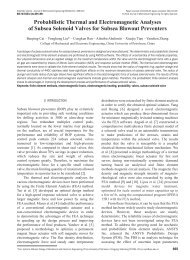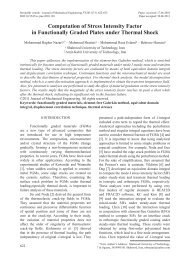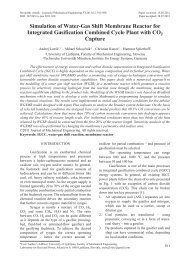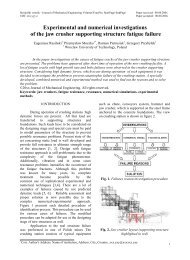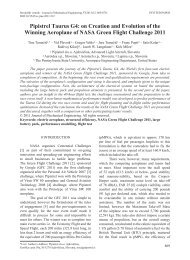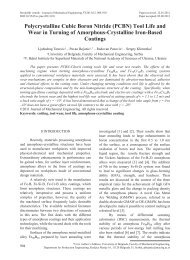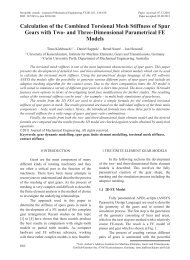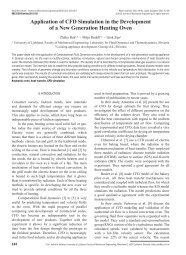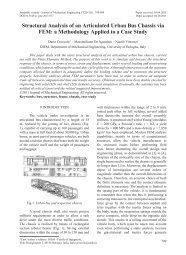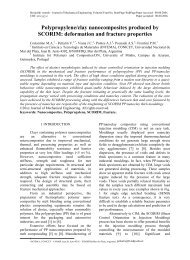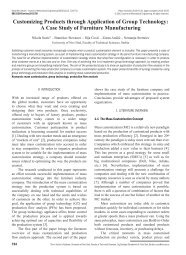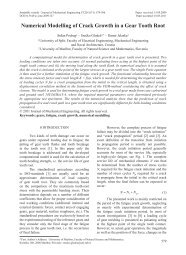Application of Promethee-Gaia Methodology in the Choice of ...
Application of Promethee-Gaia Methodology in the Choice of ...
Application of Promethee-Gaia Methodology in the Choice of ...
You also want an ePaper? Increase the reach of your titles
YUMPU automatically turns print PDFs into web optimized ePapers that Google loves.
Strojniški vestnik - Journal <strong>of</strong> Mechanical Eng<strong>in</strong>eer<strong>in</strong>g 57(2011)10, 778-784<br />
Table 2. Award function <strong>of</strong> preferention, responsive<br />
parametres and weights<br />
f 1 f 2 f 3 f 4 f 5<br />
Type III V I IV I<br />
m - 0.2 - 1.0 -<br />
n 2.5 0.5 - 2.0 -<br />
t 0.15 0.15 0.20 0.25 0.25<br />
To determ<strong>in</strong>e <strong>the</strong> <strong>in</strong>put course action <strong>the</strong> Eq<br />
(8) [4] is used:<br />
Φ<br />
+<br />
∑<br />
( a) = IPax ( , ) or Φ ( a)<br />
=<br />
x∈A<br />
∑<br />
+ x∈A<br />
IP( ax , )<br />
i −1<br />
.<br />
(8)<br />
To determ<strong>in</strong>e <strong>the</strong> output course action <strong>the</strong><br />
expression is used:<br />
IP( xa , )<br />
Φ<br />
−<br />
∑<br />
( a) = IPxa ( , ) or Φ ( a)<br />
=<br />
x∈A<br />
−<br />
∑<br />
x∈A<br />
i −1<br />
.<br />
(9)<br />
The obta<strong>in</strong>ed results are shown <strong>in</strong> Table 3,<br />
accord<strong>in</strong>g to [8] and [10].<br />
Table 3. Input, output and clean course <strong>of</strong><br />
preferention<br />
Ф+ Ф - Ф<br />
Pneumatic dryer 0.6250 0.3750 0.2500<br />
Rotation dryer<br />
with a drum<br />
0.2625 0.6750 -0.4125<br />
Rank<strong>in</strong>g action on <strong>the</strong> base <strong>of</strong> <strong>the</strong> weight<br />
clean course. On <strong>the</strong> o<strong>the</strong>r hand, <strong>the</strong> Prome<strong>the</strong>an<br />
II provides a complete rank<strong>in</strong>g, Fig. 2. It is based<br />
on <strong>the</strong> balance <strong>of</strong> <strong>the</strong> two preference flows. The<br />
<strong>in</strong>formation looks more reliable but some part<br />
<strong>of</strong> it gets lost <strong>in</strong> <strong>the</strong> process. Both Prome<strong>the</strong>an I<br />
and II help <strong>the</strong> decision-maker to f<strong>in</strong>alize <strong>the</strong><br />
selection <strong>of</strong> <strong>the</strong> best compromise. A clear view <strong>of</strong><br />
<strong>the</strong> outrank<strong>in</strong>g relations between <strong>the</strong> alternatives<br />
is obta<strong>in</strong>ed.<br />
It is clear <strong>the</strong> <strong>Prome<strong>the</strong>e</strong> I and II rank<strong>in</strong>gs<br />
are <strong>in</strong>fluenced by <strong>the</strong> weights allocated to <strong>the</strong><br />
criteria. A special feature <strong>of</strong> <strong>the</strong> s<strong>of</strong>tware, called<br />
The Walk<strong>in</strong>g Weights, Fig. 3, allows to modify <strong>the</strong><br />
weights and to observe <strong>the</strong> result<strong>in</strong>g modifications<br />
<strong>of</strong> <strong>the</strong> <strong>Prome<strong>the</strong>e</strong> II rank<strong>in</strong>g. For <strong>the</strong> follow<strong>in</strong>g<br />
weight distribution [21] to [23] it can be easily<br />
observed that pneumatic driers still dom<strong>in</strong>ates <strong>the</strong><br />
o<strong>the</strong>r ones. It is a position, as <strong>the</strong> best compromise,<br />
which seems to be very stable. On <strong>the</strong> o<strong>the</strong>r<br />
hand, <strong>the</strong> rank<strong>in</strong>g <strong>of</strong> <strong>the</strong> last five actions is now<br />
completely opposite. Such a sensitivity analysis<br />
tool is particularly valuable when <strong>the</strong> decisionmaker<br />
has no predeterm<strong>in</strong>ed weights <strong>in</strong> m<strong>in</strong>d.<br />
The <strong>in</strong>formation relative to a decision<br />
problem <strong>in</strong>clud<strong>in</strong>g k criteria can be represented <strong>in</strong> a<br />
k-dimensional space. The GAIA plane is obta<strong>in</strong>ed<br />
by projection <strong>of</strong> this <strong>in</strong>formation on a plane such<br />
that as few <strong>in</strong>formation as possible get lost. Po<strong>in</strong>ts<br />
and criteria represent alternatives. The conflict<strong>in</strong>g<br />
character <strong>of</strong> <strong>the</strong> criteria appears clearly, <strong>in</strong> Fig.<br />
Fig. 1. <strong>Prome<strong>the</strong>e</strong> I rank<strong>in</strong>g<br />
Fig. 2. <strong>Prome<strong>the</strong>e</strong> II rank<strong>in</strong>g<br />
<strong>Application</strong> <strong>of</strong> <strong>Prome<strong>the</strong>e</strong>-<strong>Gaia</strong> <strong>Methodology</strong> <strong>in</strong> <strong>the</strong> <strong>Choice</strong> <strong>of</strong> Systems for Dry<strong>in</strong>g Paltry-Seeds and Powder Materials<br />
781



